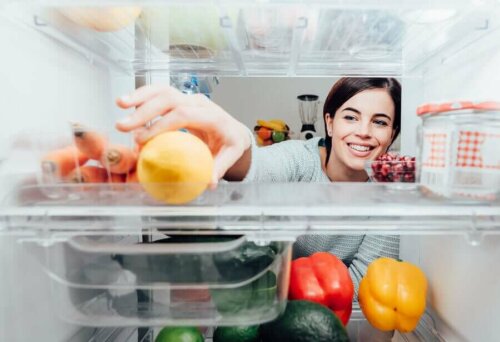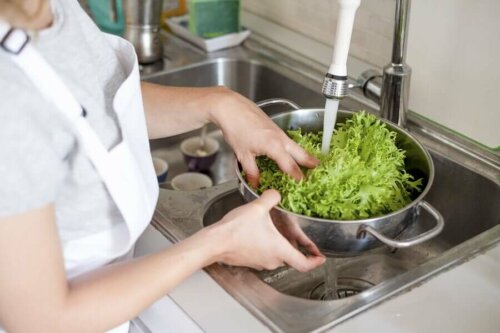Cross Contamination - What Is It?


Written and verified by the nutritionist Florencia Villafañe
Cross contamination is one of the most common causes of food-borne illnesses. But how does it happen? In today’s article, we’ll tell you everything you need to know about it.
One of the most important factors in the development of food-borne illness is the poor management of edibles. According to the Secretary of Agriculture, Livestock and Fisheries, storage, cooking, washing raw materials, hygiene of utensils, among others, are the determinants of possible food poisoning.
When the processes of food production, preservation, and storage aren’t properly controlled, the possibility of contamination increases.
Cross-contamination: what is it?
This occurs when biological, physical, or chemical contaminants pass from one food that has them to another that doesn’t.
Biological agents include bacteria, viruses, and fungi; physical ones might be fragments of steel wool, glass, plastics, or hair. Chemical agents could be anything along the lines of remains of fertilizers, pesticides, disinfectants, etc.

It may interest you: 6 Food Storage Mistakes to Avoid in Order to Keep Food Fresh
Direct cross-contamination
It occurs when a food toxin comes into direct contact with one that isn’t. For example, some food that isn’t properly sanitized comes into contact with another that isn’t contaminated. For example, this could happen when mixing a contaminated tomato with the rest of the ingredients that comprise a salad.
There’s also direct cross-contamination when storing food improperly in the fridge and ready-to-eat products come into contact with raw products.
Indirect cross-contamination
Similarly, this occurs when the contaminating agents pass from one item to another via a third element. It could be a knife, a cutting board, other forms of kitchen equipment, or even the hands. A clear example is the use of a knife you first used to cut raw meat, and then you use it to cut a slice of pie.
Things to consider when handling food
Thus, proper hygiene of the place where you prepare food such as utensils, equipment, and others is crucial to avoid cross-contamination. By hygiene, we mean maintaining overall cleanliness and disinfecting all working areas and equipment. So:
- Remove visible dirt from surfaces, such as food debris, by using water, detergents, and brushes, among other elements
- Disinfect to eliminate microorganisms via chemicals such as bleach, and hot water. Keep in mind that disinfection isn’t a substitute for cleaning. In fact, it’s only effective for items you’ve already washed
- Start with the dirtiest and work your way to the cleanest

It may interest you Six Food Storage Mistakes to Avoid in Order to Keep Food Fresh
Cross-contamination: measures to avoid it
Take into account the following measures in order to reduce the risk:
- Keep cleaning and disinfection chemicals stored in a special place, away from food.
- Periodically clean the kitchen work surfaces with hot water and detergents; never let them come into contact with any animals you might have in your household.
- Use disposable paper towels for cleaning surfaces. When using kitchen towels or dishcloths, you must exercise proper hygiene and replace them whenever it’s necessary.
- Rinse the treated surface and utensils after disinfection to completely remove any disinfectant residue. Don’t use detergent and bleach together. This is because the detergent inactivates the bleach and this decreases its disinfecting action.
- When preparing food, make sure the necessary utensils and equipment are clean and properly disinfected.
- Once you’re done handling raw food and before handling cooked products, clean and disinfect all utensils, equipment, and tables.
- Cover the food with a plastic film or place it inside airtight bags or a container before storing them in the fridge.
- Place raw foods at the bottom of the fridge to keep its juices from contaminating ready-to-eat items. Protect any cuts or injuries with waterproof bandages and treat them with an antiseptic. Also, don’t cook if you’re sick or have a skin infection.
- Wash your hands with soap and water before, during, and after preparing food. Also do so whenever you handle raw food, after using the bathroom, and after you handle chemical products.
Things to be clear about
There are many points of contamination and it’s nearly impossible to detect if a food portion came into contact with it or not. However, if you take all of the above into account when handling food, you’ll definitely decrease the risk of food poisoning.
All cited sources were thoroughly reviewed by our team to ensure their quality, reliability, currency, and validity. The bibliography of this article was considered reliable and of academic or scientific accuracy.
- Ministerio de Agricultura, Ganadería y Pesca [Internet]. Argentina.gob.ar. 2018 [citado 30 de abril de 2020]. Disponible en:http://www.alimentosargentinos.gob.ar/HomeAlimentos/Nutricion/fichaspdf/Ficha_2_ContC.pdf
- Torrens R, Argilagos B, Cabrera S, Valdés B, Sáez M, Viera G. Las enfermedades transmitidas por alimentos, un problema sanitario que hereda e incrementa el nuevo milenio. Redvet. [Internet].2015.[30 de abril 2020]; (8)16:28. Disponible
en:https://www.redalyc.org/pdf/636/63641401002.pdf - Delgado R, Gutiérrez C, Hurtado A. Enfermedades transmitidas por alimentos (ETA) de origen marino en Nueva Esparta II. Características clínicas y etiológicas.[Internet]. 2003 [citado 30 de abril 2020] ; 34( 2 ): 11-16. Disponible en: http://ve.scielo.org/scielo.php?script=sci_arttext&pid=S0798-04772003000200003&lng=es.
- Mylius, S. D., Nauta, M. J., & Havelaar, A. H. (2007). Cross-Contamination During Food Preparation: A Mechanistic Model Applied to Chicken-Borne Campylobacter. Risk Analysis, 27(4), 803–813. https://doi.org/10.1111/j.1539-6924.2006.00872.x
This text is provided for informational purposes only and does not replace consultation with a professional. If in doubt, consult your specialist.








